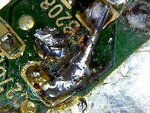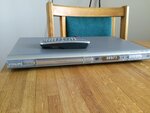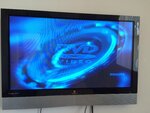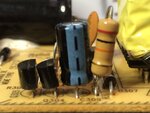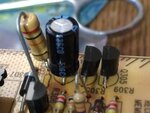aromring
Newbie level 4
Day 0:
It's late April and a cute coworker of mine is in despair. She brings her broken Philips DVD player (DVP642, like this:
http://salestores.com/philip27.html)
to the office in hope that someone might help her. What's so special about 11-year old DVD player? - you might ask. Just throw it away and buy a new one; these are not expensive, right? Well, what's special about this particular player is the fact that it's easily hackable. She entered a special code years ago, made it region-free, and ever since can play movies from all over the world in both NTSC and PAL formats. It's particularly golden for someone like her who likes foreign movies. One of such rare foreign discs is now stuck in the drawer which doesn't want to open. "Help me" - she pleads - "at this point I don't care if you have to break apart the player, just get my disc out!". All right, since I have a few simple tools in my office I sit down, unscrew the drawer, and after 1 minutes figure out how to open it manually by shifting a white plastic guide at the bottom. "Here it is" - I hand over the disc.
That would be over for most people, but not for me. About a week ago I passed the final exam in the last part of the 3-part on-line course in basic electronics
(
**broken link removed**
) - my new hobby. I am so empowered and bursting with circuit theory that feel a primal need to turn all this new knowledge into practice. "Tell you what" - I tell my colleague - "I'll fix your player at no charge. I truly need to practice my new skills in the real world. Your broken Philips is an excellent object!" Fortunately, she agrees and I take the player home.
Day 1:
From what I gather, the DVD player worked fine for 10 years, then started acting up: the drawer would open only half way, for example. Sometimes it wouldn't turn on. Finally, it completely gave up with the dreaded blinking power light. Even the front display stays blank.
Initially, the repair seems easy. I already know that the main reason why consumer electronics breaks is limited life of electrolytic capacitors, especially in high temperature environment:
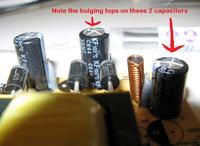
[from www . markdigital . com/wp-content /uploads /2011/02 /bulging_capacitors.jpg]
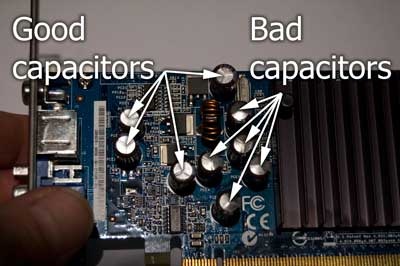
[from www . geeksinphoenix .com /blog /images /Computer_Randomly_Freezes_Up_01.jpg]
The electrolyte gradually dries up, or boils out, the ESR shoots up, while capacity dives down. Often this happens because manufacturers place capacitors next to hot elements, like transistors or power resistors… No, it's not about bad design, it's all about obsolescence _by_ design. More on this later.
I google DVP642 up and sure enough, here pops up this YouTube video:
Turns out, a bad 1000 microF capacitor, C316, in a switched mode power supply is the culprit responsible for failure of many DVP642's. I take a closer look at the power supply board it's LVP103850. C316 looks fine. It's C310, a 470 uF capacitor on the +12V line that is bulging. "Easy!" - I think. But when I replace it with a new, good one and… the DVD player still doesn't turn on. Hmmm, it's more complicated than I thought.
To be continued.
It's late April and a cute coworker of mine is in despair. She brings her broken Philips DVD player (DVP642, like this:
http://salestores.com/philip27.html)
to the office in hope that someone might help her. What's so special about 11-year old DVD player? - you might ask. Just throw it away and buy a new one; these are not expensive, right? Well, what's special about this particular player is the fact that it's easily hackable. She entered a special code years ago, made it region-free, and ever since can play movies from all over the world in both NTSC and PAL formats. It's particularly golden for someone like her who likes foreign movies. One of such rare foreign discs is now stuck in the drawer which doesn't want to open. "Help me" - she pleads - "at this point I don't care if you have to break apart the player, just get my disc out!". All right, since I have a few simple tools in my office I sit down, unscrew the drawer, and after 1 minutes figure out how to open it manually by shifting a white plastic guide at the bottom. "Here it is" - I hand over the disc.
That would be over for most people, but not for me. About a week ago I passed the final exam in the last part of the 3-part on-line course in basic electronics
(
**broken link removed**
) - my new hobby. I am so empowered and bursting with circuit theory that feel a primal need to turn all this new knowledge into practice. "Tell you what" - I tell my colleague - "I'll fix your player at no charge. I truly need to practice my new skills in the real world. Your broken Philips is an excellent object!" Fortunately, she agrees and I take the player home.
Day 1:
From what I gather, the DVD player worked fine for 10 years, then started acting up: the drawer would open only half way, for example. Sometimes it wouldn't turn on. Finally, it completely gave up with the dreaded blinking power light. Even the front display stays blank.
Initially, the repair seems easy. I already know that the main reason why consumer electronics breaks is limited life of electrolytic capacitors, especially in high temperature environment:

[from www . markdigital . com/wp-content /uploads /2011/02 /bulging_capacitors.jpg]

[from www . geeksinphoenix .com /blog /images /Computer_Randomly_Freezes_Up_01.jpg]
The electrolyte gradually dries up, or boils out, the ESR shoots up, while capacity dives down. Often this happens because manufacturers place capacitors next to hot elements, like transistors or power resistors… No, it's not about bad design, it's all about obsolescence _by_ design. More on this later.
I google DVP642 up and sure enough, here pops up this YouTube video:
Turns out, a bad 1000 microF capacitor, C316, in a switched mode power supply is the culprit responsible for failure of many DVP642's. I take a closer look at the power supply board it's LVP103850. C316 looks fine. It's C310, a 470 uF capacitor on the +12V line that is bulging. "Easy!" - I think. But when I replace it with a new, good one and… the DVD player still doesn't turn on. Hmmm, it's more complicated than I thought.
To be continued.
Last edited by a moderator:

